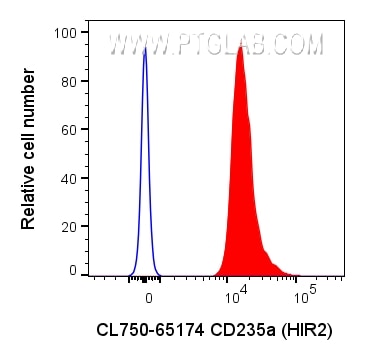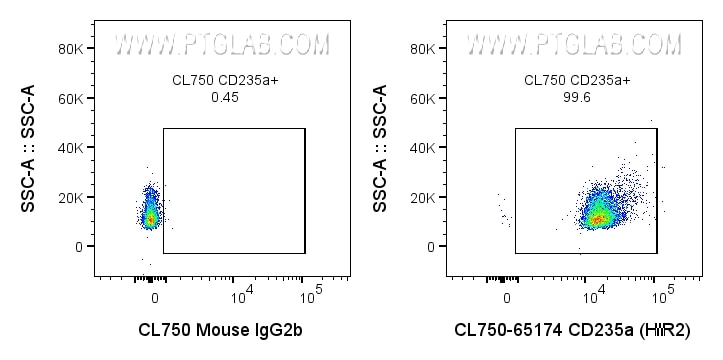Anticorps Monoclonal anti-Glycophorin A/CD235a
Glycophorin A/CD235a Monoclonal Antibody for FC
Hôte / Isotype
Mouse / IgG2b, kappa
Réactivité testée
Humain
Applications
FC
Conjugaison
CoraLite® Plus 750 Fluorescent Dye
CloneNo.
HIR2
N° de cat : CL750-65174
Synonymes
Galerie de données de validation
Applications testées
| Résultats positifs en cytométrie | human whole blood, |
Dilution recommandée
| Application | Dilution |
|---|---|
| This reagent has been pre-titrated and tested for flow cytometric analysis. The suggested use of this reagent is 5 µl per 10^6 cells in a 100 µl suspension or 5 µl per 100 µl of whole blood. | |
| Sample-dependent, check data in validation data gallery | |
Informations sur le produit
CL750-65174 cible Glycophorin A/CD235a dans les applications de FC et montre une réactivité avec des échantillons Humain
| Réactivité | Humain |
| Hôte / Isotype | Mouse / IgG2b, kappa |
| Clonalité | Monoclonal |
| Type | Anticorps |
| Immunogène | Peptide synthétique (humain, N-terminal) |
| Nom complet | glycophorin A (MNS blood group) |
| Masse moléculaire calculée | 150 aa, 16 kDa |
| Numéro d’acquisition GenBank | BC005319 |
| Symbole du gène | Glycophorin A |
| Identification du gène (NCBI) | 2993 |
| Conjugaison | CoraLite® Plus 750 Fluorescent Dye |
| Excitation/Emission maxima wavelengths | 755 nm / 780 nm |
| Forme | Liquide |
| Méthode de purification | Purification par affinité |
| Tampon de stockage | PBS with 0.09% sodium azide and 0.5% BSA |
| Conditions de stockage | Store at 2-8°C. Avoid exposure to light. Stable for one year after shipment. |
Informations générales
Glycophorin A (GYPA) is the major transmembrane sialoglycoprotein in erythrocytes. It is a dimeric type I transmembrane protein carrying 15 closely clustered O-linked tetrasaccharides capped with sialic acid/N-acetylneuraminic acid (Neu5Ac). This 36 kDa protein represents the major sialoglycoprotein of the red blood cell membrane displaying about one million copies per cell. (PMID: 9490702)
Protocole
| Product Specific Protocols | |
|---|---|
| FC protocol for CL Plus 750 Glycophorin A/CD235a antibody CL750-65174 | Download protocol |
| Standard Protocols | |
|---|---|
| Click here to view our Standard Protocols |



